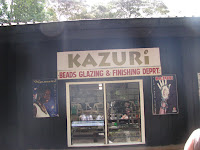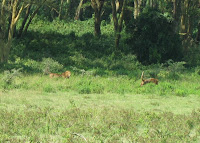Cathy sent me the information and I got in touch with Becky Fuchs who was making the arrangements for the group. We verified that the spots were still open. Ed and I took a look at our budget; and, since we don't normally follow it anyway when we travel, we decided to take the plunge and sign up.
We then realized Ed's passport would expire in a month, so the paperwork began in getting it renewed. Next came the application for visas to both Kenya and Tanzania. AND THEN, we found out about all the vaccinations and medicines that we would need before we could go. Ed commented that if he had known he was going to have so many shots, he might have said no. (Note: it is now 60 days from the start of the trip, and we are just finishing our dosages of malaria pills.)
The initial tour flight was to go through Amsterdam. We had researched taking a couple of extra days in Europe, but the stopover cost was not feasible. So when the tour company called to tell us that they could not get us on the Amsterdam flight, and we would be flying through Dubai, United Arab Emirates, without a stopover fee, we jumped on the chance to see another country. So we booked a hotel in Dubai and started looking at what we could see in a two day visit.
In the meantime, we had also researched various websites, and talked to friends, about what we should take with us. It was also recommended that we spray our safari outerwear with permidian to protect against mosquitos and other critters.
Ed spraying our safari clothing
Luckily we had learned to pack in small duffels when we took our Alaskan trip in 2018. But, we still found it difficult to fit everything we needed into our duffels and meet the airline/tour requirements. This time, along with the hair dryer, the laptop had to stay at home. We did switch to a new phone contract and made arrangements to do texting while we were in Africa. Based on recommendations, we had packed extra spray bottles of Deet and the recommended sunscreen.
Becky and her husband Jim had a potluck at their house for last minute instructions/questions and to give Ed and I an opportunity to meet the other 13 that would be going on this adventure.
had a potluck at their house for last minute instructions/questions and to give Ed and I an opportunity to meet the other 13 that would be going on this adventure.
 had a potluck at their house for last minute instructions/questions and to give Ed and I an opportunity to meet the other 13 that would be going on this adventure.
had a potluck at their house for last minute instructions/questions and to give Ed and I an opportunity to meet the other 13 that would be going on this adventure.
Our flight left Denver for Dallas at 7:00 AM on July 10. We found out that the shuttle from Fort Collins did not start early enough to get us there in time for the flight. So, we caught the last shuttle the night before and spent our first night on vacation in the lounge chairs at DIA. (We had thought about getting a motel, but figured we probably wouldn't get much sleep anyway.)
After getting checked in and passports checked, we were on our way. We were able to take a catnap on the way to Dallas. We then arrived at our next boarding location. We would be flying Emirates Air to Dubai (a 14-hour journey). When we looked out the window, we could hardly see the end of the plane. Take a look at the airlines website and check out the first /business class seating. http://www.emirates.com/us/english/flying/cabin_features/cabin_features.aspx Of course, we were in economy, but the legroom was better than we had had on any other airline.
Our flight left Dallas at 5:00 PM, and we were immediately given warm towels to freshen ourselves; offered cocktails (for free),
and then a full course dinner followed w/cocktails. Soon after that the lighting was dimmed in the plane and their were "twinkling" stars on the ceiling to give the passengers a feel of nighttime. If you were tired, you were able to plug in your cell phone and play games; or they offered about 18 movie channels, various music, and additional games. If you were awake at midnight, they gave you pizza and a drink. Then when morning came, the warm towels were distributed to freshen up and
breakfast was served.
There is a 10-hour time change between Denver and Dubai. We arrived in Dubai at noon. We had traveled 8,267 miles. This was more seat-time miles than we had spent on the entire Alaskan motorcycle trip.
We had made prior arrangements with our hotel to pick us up at the airport. We retrieved our luggage and passed through customs.
After reading on the website, we were concerned about customs -- they banned certain prescription drugs from coming into the country. We were flagged on through without any questions or search. We then stopped at the Visa desk. We had read that American citizens could get a temporary visa. The desk told us this would be handled at our hotel.
The temperature was warm when we arrived. Our ride from the airport was however quite comfortable due to the town car's air conditioning. (A lot different than our hotel shuttles back home.) Upon check-in we were told that we had arrived during Ramadan and there were some guidelines that we would need to follow. Ramadan is the Muslim celebration that believes one's self is improved through fasting from sunrise to sunset. This would allow them to practice and develop patience, perseverance and discipline while encouraging people to rise above basic human desires.
This meant that most of the restaurants would be closed during this time. The hotel had arranged to have a breakfast available for guests, as well as afternoon tea, a cocktail hour, and snacks after sunset. Drinks were also not allowed (including water) during the fast, so they asked that we be discreet. We stayed at the Radisson Blu and it was located on Dubai Creek in the older section of the city.
First to visit on the Dubai agenda was the tallest skyscraper in the world. We wanted to see the area at sunset, so we had purchased our tickets ahead of time. We took a short nap, and then took a taxi to the skyscraper.
The skyscraper is 160 stories high. The observation deck is located on the 142nd floor. We were expecting a ride similar to that of the Empire State Building, and were quite surprised that the ride only took about 4 seconds. No change in air pressure. When the doors opened, there was a fantastic view in front of us.
 |
| Persian Gulf |
 |
| Downtown - Interchange |
 |
| Persian Gulf at sunset |
Iftar (part of Ramadan) is when Muslims break their fast at sundown by eating dates and sharing their food and conversation with others. We were surprised when we were invited to participate in Iftar at the top of the skyscraper. Everyone was given a boxed meal which had various types of foods made from dates. A hot drink was also offered.
The following morning we chose to catch the Hop-On-Hop-Off-Bus-Tour. We figures that this would give us the best view of Dubai during our one day we had in the city. There was a bus stop not far from the hotel, so after breakfast we headed out for our adventure. Luckily the bus company provided bottles of water, because the temperature reached 110 that day.
The bus ride first took us to the new section of Dubai. With the "new" city being as young as it is, we were amazed by the organization of both the airport and the roadways throughout the city. As Ed noted, the city was an example of wealth. All the taxi cabs were Lexuses. There are two routes to be followed on the tour -- we chose the one along the coastline because we wanted to say we had waded in the Persian Gulf. The hotel next to the public beach has an 8-star rating and is used exclusively by the rich and famous. It is built on its own island, and is in the shape of a sail.

After the visit to the beach, the bus ride took us past the Atlantis of the Palm hotel. This is designed after the famous Atlantis Hotel in the Bahamas. Contractors have brought in sand and built several islands into the gulf. The shape of these islands is that of a palm tree. The Atlantis is at the end (or top) of the island.
After visiting this side of town, it was getting close to lunchtime, so we headed over to the Hard Rock Café. A shuttle from the tour takes you to and fro. We had lunch here. We then visited the Ferrari store next door and then continued on our tour. As we got closer to the older section of town (where our hotel was located) we ventured out on a Dhow ride on Dubai Creek. It was quite warm and uncomfortable, but we did learn a lot about the history of Dubai.
 | ||

|
Dubai is one of seven emirates that make up the country. First recorded history is in 1799 as a fishing village near Dubai Creek. Then because of its strategic location, it grew with the import/export trade. Freighters from all countries in the area can be seen in the harbor. When oil was discovered in 1966, the city grew by leaps and bounds. It is said to be now the 22nd most expensive city in the world.
After the Dhow ride, we returned to the bus and traveled through the oldest section of the city. Here we saw the Dubai Museum (previously the Al Fahidi Fort), the Heritage Village and Sheikh Saeed Al Maktoum's House which are all open to the public if you have time to visit.
We passed by the Gold Souk (shopping) and the Spice Souk before reaching our hotel. Outside the Spice Souk they were unloading many freighters that had brought in many types of spices for trade. From here we reached our stop -- we were both fatigued from the heat -- the bus driver noticed this and took us to the front of the hotel. This is one of the many courtesies we had while visiting here. We stopped in for some libation and headed to the room for a good night's sleep.
 |
| Spice Souk |
The following day we had a lazy morning -- tried to get everything back into the duffle bags and head to the airport for our 6- hour flight to Nairobi. Being on Emirates Air we knew we would be comfortable for the duration of the trip. Soon the warm towels, cocktails and lunch were served.
Go to http://www.emirates.com/us/english/destinations_offers/discoverdubai/aboutdubai/index.aspx to learn more about Dubai and the many sights available to tour.











































































